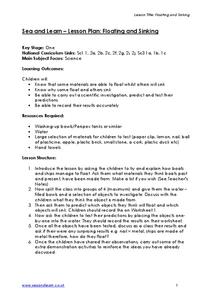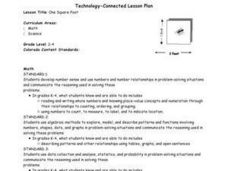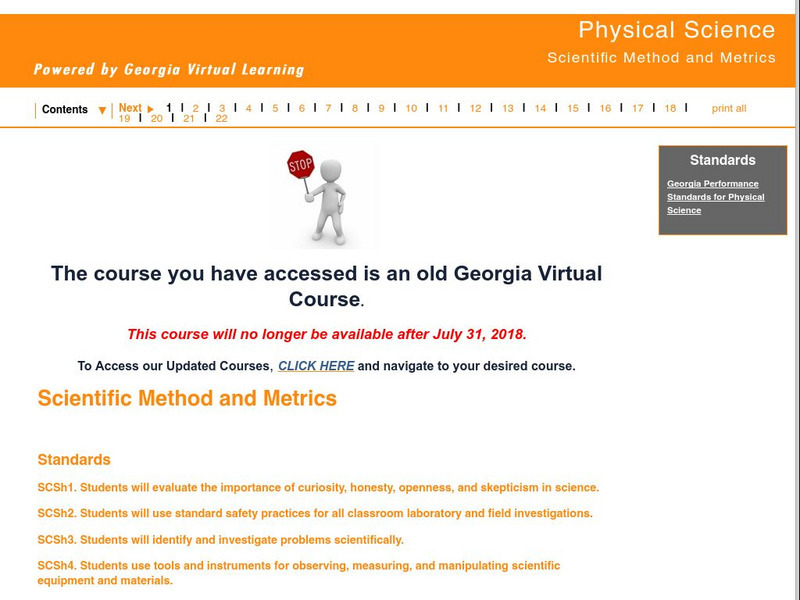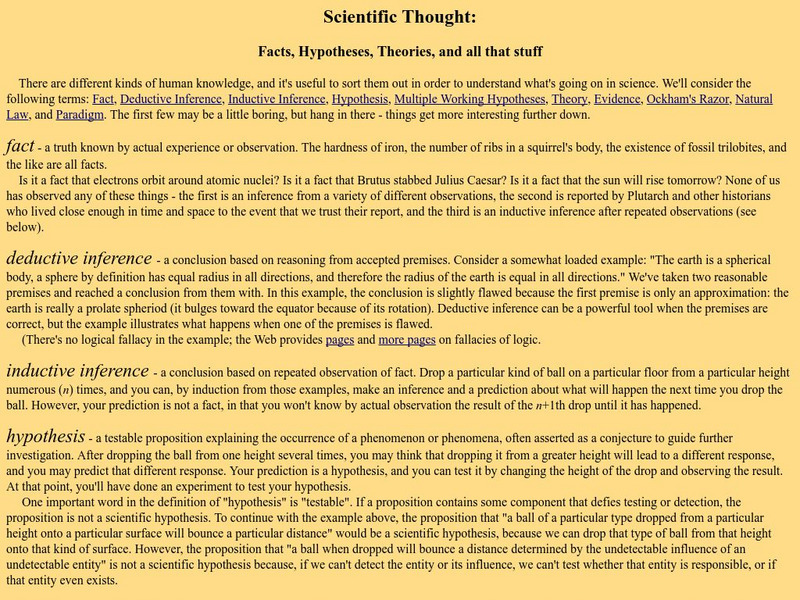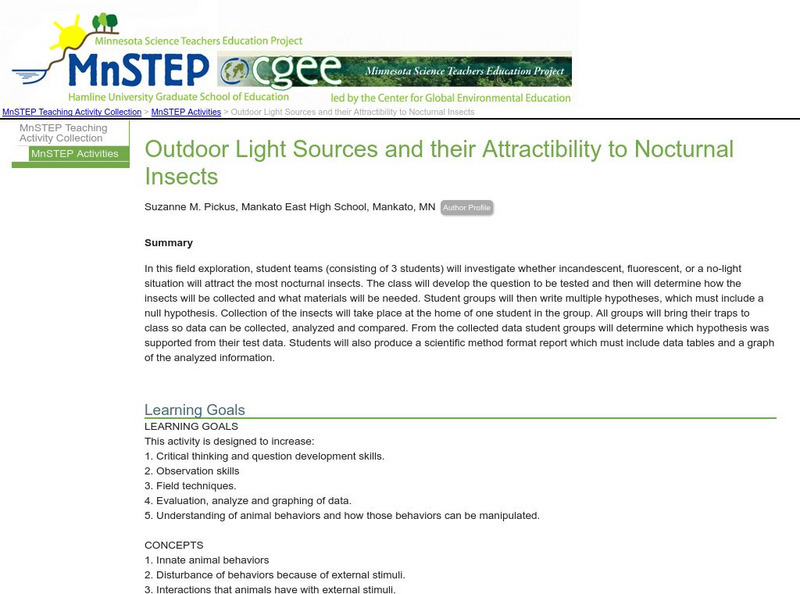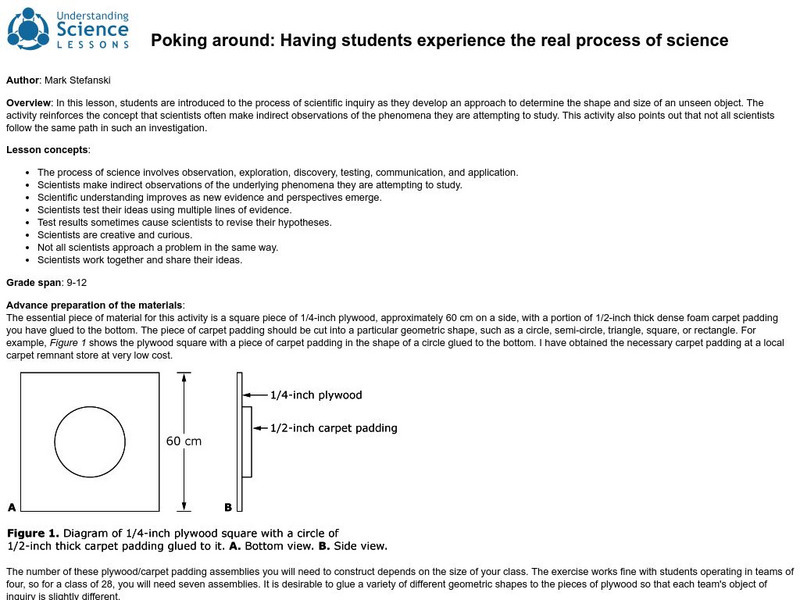Curated OER
Inclined Plane 1
In this scientific investigation worksheet, students follow the provided procedures to create an inclined plane paper model and then respond to 1 short answer question.
Curated OER
Tree I.D.
Students explore various tree species. In this tree species lesson, students collect leaves on nature walks and use Internet sources to identify the trees that the leaves belong to. Students graph their data as well.
Curated OER
Student Designed Investigations Part 2 – Testable Questions, Predictions, Materials and Procedures
Students create their own investigations. For this science experiments lesson, students use the steps of the scientific method to design an investigation. Students share their findings on a poster.
Curated OER
Floating and Sinking
Students conduct experiments in which they investigate which materials float and which sink. They examine what qualities the materials that float have in common. They carry out a scientific investigation, predict, and test their...
Curated OER
Let's Investigate Tooth Decay
Students conduct a simple investigation to explore tooth decay.
Curated OER
Let's Measure the Speed of Sound
Third graders measure the speed of sound using scientific investigative techniques.
Curated OER
Weight in Water
Pupils investigate why some materials are able to float while others sink. They carry out a scientific investigation, predict and test their predictions. They record their results in a spreadsheet, and use a forcemeter in another...
Curated OER
Communication in Bees
Eighth graders identify and interpret a scientific investigation and a hypothesis through experimentation and testing a hypothesis. They identify what scientists hypothesized about the communication of stingless bees. Finally, 8th...
Curated OER
One Square Foot
Students identify, describe, count, tally, and graph life found in one square foot of land.
Exploratorium
Exploratorium: From Jungle to Lab: The Study of Life's Complexity
An exhibit on what field biologists do. Hear from scientists who have worked in Belize about the reasons that they chose their career paths, the ideas that drive them in their research, the investigative tools they use, and about the...
Georgia Department of Education
Ga Virtual Learning: Physical Science: Scientific Method and Metrics
Students have the opportunity to review the scientific method, become familiar with vocabulary terms associated with scientific investigation, and learn about real-world scientific examples where the method is used.
Hunkins Experiments
Hunkin's Experiments
This amazing website provides access to 200 exciting experiments from cartoonist, broadcaster, and engineer, Tim Hunkin. Each experiment is categorized and illustrated.
University of Georgia
University of Georgia: Scientific Thought: Facts, Hypotheses, Theories, Etc.
Provides explanations of terms used in science: fact, deductive inference, inductive inference, hypothesis, multiple working hypotheses, theory, evidence, Ockham's Razor, natural law, and paradigm.
Science Education Resource Center at Carleton College
Serc: Our Big Backyard
An activity for students to fine tune their observation skills using their senses in their own backyard. During this activity, students will record their observation to compare and contrast living things over a period of different seasons.
Science Education Resource Center at Carleton College
Serc: Outdoor Light Sources and Their Attractibility to Nocturnal Insects
A field investigation where students experiment with whether incandescent, fluorescent, or a no-light situation will attract the most nocturnal insects. Working in teams, students create a hypothesis and procedure to complete this field...
University of California
University of California at Berkeley: Understanding Science: Mystery Tubes
Students collaborate to create a drawing or model of what the inside of a mystery tube looks like. The tube has two ropes attached to a ring inside it. Students must use their powers of observation and deduction to try to understand how...
Vision Learning
Visionlearning: Culture of Science: Scientists and the Scientific Community
A look at the human side of science. Take a look at how background and motivation can lead to different perspectives, discoveries, and progress in science.
Harvard University
Harvard Smithsonian: Everyday Classroom Tools
The focus of this series of lessons is to engage students in an exploration of the world around them. The emphasis is on inquiry as students learn about the earth, sun, light, shapes and more.
PBS
Pbs Learning Media: Night Light Game
Why is light important? Play this interactive night light game with PEEP and observe why we need light to see objects. Also included are teaching tips.
University of California
Q Files: Misconceptions About Science
Many students have misconceptions about what science is and how it works. This module explains and corrects some of the most common misconceptions that students are likely having trouble with.
Globe
The Globe Program: The Mystery of the Missing Hummingbirds [Pdf]
This story is an interesting way to help students understand the process of migration. It provides teachers with information on how to approach a particular lesson and its easy-to-read content is easily adaptable for grades K-12.
University of California
University of California at Berkeley: Understanding Science: Mystery Boxes
An interesting lesson where students collaborate to create a visual image of what the inside of a sealed box looks like. The box has a marble or other type of sphere inside it, as well as partitions and/or ramps. Students come to...
University of California
University of California at Berkeley: Understanding Science: Poking Around
Students work in groups to develop an understanding of the size and shape of an object hidden beneath a plywood board, asking questions, testing their reasoning, and drawing conclusions, as scientists do. Students are never permitted to...
Other
Terc: Online Science Athon: Find Out How Tall You Are
Create a Measuring Day at your school and teach your students how to use simple tools to gather, discuss and analyze their own data. This step-by-step lesson plan helps you design an unforgettable day for you and your students. Links to...





